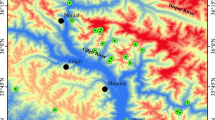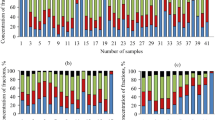Abstract
The Kuskokwim River at Bethel, Alaska, drains a major mercury-antimony metallogenic province in its upper reaches and tributaries. Bethel (population 4000) is situated on the Kuskokwim floodplain and also draws its water supply from wells located in river-deposited sediment. A boring through overbank and floodplain sediment has provided material to establish a baseline datum for sediment-hosted heavy metals. Mercury (total), arsenic, antimony, and selenium contents were determined; aluminum was also determined and used as normalizing factor. The contents of the heavy metals were relatively constant with depth and do not reflect any potential enrichment from upstream contaminant sources.
Similar content being viewed by others
References
Aruscavage PJ (1977) Determination of arsenic, antimony, and selenium in coal by atomic absorption spectrometry with a graphite tube atomizer. Journal of Research US Geological Survey 5:405–408
Baudo R and Muntau H (1990) Chapter 1: Lesser known in-place pollutants and diffuse source problems. In: Baudo R, Giesy JP, and Muntau H (Eds), Sediments: Chemistry and toxicity of inplace pollutants. Ann Arbor: Lewis Publisher, pp. 1–14
Briggs PH and Crock JG (1986) Automated determination of total selenium in rocks, soils, and plants. US Geological Survey Open File Report, 86–40, 8 pp
Cady WM, Wallace RE, Hoare JM and Webber EJ (1955) The Central Kuskokwim Region, Alaska. US Geological Survey Professional paper 268, 132 pp
Crock JG and Lichte FE (1982) An improved method for the determination of arsenic and antimony in geological materials by automated hydride generation atomic absorption spectrometry. Anal Chim Acta 144:223–233
Ehrlich HL (1990) Geomicrobiology, 2nd ed. New York: Marcel Dekker, 646 pp
Flanagan FJ, Moore R and Aruscavage PJ (1982) Mercury in geologic reference samples. Geostand Newslett 6:25–46
Förstner U, Ahlf W, Calmano W and Kersten M (1990) Sediment criteria development. In: Heling D, Rothe P, Förstner U, and Stoffers P (Eds), Sediments and Environmental Geochemistry. Berlin: Springer-Verlag, pp 311–338
Gibbs RJ (1973) Mechanisms of trace metal transport in rivers. Science 180:71–73
Gibbs RJ (1977) Transport phases of transition metals in the Amazon and Yukon rivers. Bull Geol Soc Am 88:829–843
Gough LP, Shacklette HT and Case AA (1979) Element concentrations toxic to plants, animals, and man. US Geological Survey Bulletin 1466, 80 pp
Gray JE, Goldfarb RJ, Detra DE and Slaughter KE (1991) Geochemistry and exploration criteria for epithermal cinnabar and stibnite vein deposits in the Kuskokwim River region, southwestern Alaska. J Geochem Explor 41:363–386
Heit M, Klusek CS, Volchok HL and Burke JC (1980) Time history of trace elements in sediments from Standley Lake, Colorado. Environ Int 4:229–237
Hoare JM (1961) Geology and tectonic setting of lower Kuskokwim-Bristol Bay region, Alaska. Bull Am Assoc Petrol Geol 45:594–611
Jones DL, Silberling NJ, Coney PJ and Plafker G (1987) Lithotectonic terrane map of Alaska (west of the 141st meridian). US Geological Survey Miscellaneous Field Studies map MF-1874-A, scale: 1:2,500,000
Krauskopf KB (1967) Introduction to geochemistry. New York: McGraw-Hill, 721 pp
Lanning DC (1986) Kuskokwim river bank erosion. North Engi 18(2–3):32–38
Leenaers H and Rang MC (1989) Metal dispersal in the fluvial system of the River Geul: The role of discharge, distance to the source, and floodplain geometry. Sediment and the Environment (Proceedings of the Baltimore Symposium, May 1989) IAHS Publ. No. 184, pp 47–55
Lichte FE, Golightly DW and Lamothe PJ (1987) Inductively coupled plasma-atomic emission spectrometry. In: Baedecker PA (Ed), Methods for geochemical analysis US Geological Survey Bulletin 1770. pp B1–B10
Long ER (1992) Ranges in chemical concentrations in sediments associated with adverse biological effects. Mar Pollut Bull 24:38–45
Middleton R and Grant A (1990) Heavy metals in the Humber estuary:Scrobicularia clay as a pre-industrial datum. Proc Yorkshire Geol Soc 48(part 1):75–80
Miller ML, Belkin HE, Blodgett RB, Bundtzen TK, Cady JW, Goldfarb RJ, Gray JE, McGimsey RG and Simpson SL (1989) Prefield study and mineral resource assessment of the Sleetmute Quadrangle, southwestern Alaska. US Geological Survey Open-File report 89-363, 115 pp
Müller G (1979) Schwermetalle in den Sedimenten des Rheins—Veränderungen seit 1971. Umschau 79:778–783
Nelson H, Larsen BR, Jenne EA and Sorg DH (1977) Mercury dispersal from lode sources in the Kuskokwim River drainage, Alaska. Science 198(4319):820–824
Okouchi S and Sasaki S (1983) Photochemical behavior of mercury ore in water. Environ Int 9:103–106
Peng A and Wang Z (1985) Mercury in river sediments. In: Irgolic KJ and Martell AE (Eds), Environmental inorganic chemistry. VCH Publishers, pp 393–400
Thomas RL (1987) A protocol for the selection of process-oriented remedial options to control in situ sediment contaminants. Hydrobiologia 149:247–258
Wilken R-D and Hintelmann H (1991) Mercury and methylmercury in sediments and suspended particles from the River Elbe, North Germany. Water, Air, Soil Pollut 56:427–437
Wood JM (1972) A progress report on mercury. Environment 14:33–39
Author information
Authors and Affiliations
Rights and permissions
About this article
Cite this article
Belkin, H.E., Sparck, H.M. Mercury, arsenic, antimony, and selenium contents of sediment from the Kuskokwim River, Bethel, Alaska, USA. Geo 22, 106–110 (1993). https://doi.org/10.1007/BF00789322
Received:
Accepted:
Issue Date:
DOI: https://doi.org/10.1007/BF00789322




